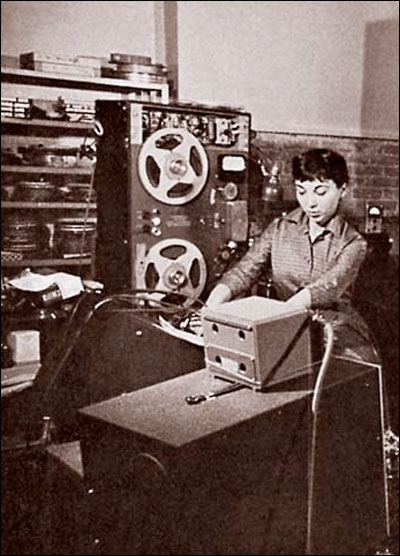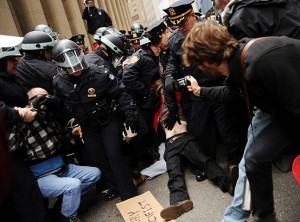
I firmly believe in the present. There literally is no past and no future, just the changing now. Sure, it contains evidence of things that have been, other circuits of the Earth around the Sun. We can be pretty certain at some point, some other now, there are even more such circuits engraved and erased upon what is. That means, of course, that it’s not strictly meaningless to talk about time. But leave aside the idea of a future and a past like a great crystal block, fixing things in some supposed and uniquely directional dimension, and you find that change is the actual substance of reality all about. Time is a construction of the speed of a regular change. Think about that metaphysical ice – it makes no sense. Where’s the present? Is it any slice you take, orthogonal to the line from past to future? But “time” is a mess. The geosynchronous satellites experience a slightly slower clock than all of us walking down here in the gravity well. The red-shifted galaxies tick slower still. When is now, in that universe-cube? Am I a four dimensioned worm, growing from the fetus-tail to the aged and decomposing head, unchanging yet experiencing one segment at a moment? A flip-book, with each page pre-written? Bull. My experience is the present. The light of those galaxies leaves them in their present and reaches me in my present. Everything happens where the change happens, because change is what there is.
This moment is deeper than an instant. That famously uncertain cat has a smear of present, each one a possibility of disaster. It experiences each but only one. Are the others still there, branches pruned from the tree of this-cat-present, burning in some irrecoverable parallel? Until the box is opened, I experience that smear as cat-reality. Opened, my smear is likewise pruned as this-cat-present cuts apart the tree of what I see. Or so you’d think, but you think that way to make tigers persistent in the long grass when our distant relatives had lost the smell and sight of them. It’s a necessary trick of the mind’s eye, harder to see than the past-future illusion but from the same cause. The absent tiger isn’t in my present, not even the box of undecidable cats is here. What’s here is the sight of the box, or the supposition that the present will change to include a tiger if I’m not rather careful.
That’s how I can experience the superimposition of cats or, on opening the box, generate in the experience of some more distant particle or person the effect of a superimposition of myself. But I cannot experience being a superimposition. One can suppose, from for example the various cats, that things like me – who call themselves me – experience presents like this one or very different. That’s the small truth, the best model predicting how the present changes. The big truth is the one the models and predictions obscure, this perfect flow of what *is*. And everything is, although very little of that happens in any one experience.
Experience and belief are inseparable. Each generates the other. Beliefs are genetically imprinted consequences of our perception systems; they are also taught, cultural things which fasten onto and reinforce those basic proclivities; and perhaps they can be chosen, no longer habits of thinking but consciously re-patterned thought processes and methods of perception. Beliefs shape our perception which shapes our experience which causes belief. It takes quite a bit of thought and imagination to tease this cycle apart, but it can be done because at the deepest level we require the world to make sense – to be consistent with itself. In other words we require the beliefs, which are in the end patterns, to fit throughout our experience and in harmony with one another. Even where a religious person says “that’s a matter of faith, not science” they don’t mean that has no pattern, they mean it is part of the religious pattern and the science pattern. But they’re aware a serious discomfort in this claim. All patterns should match with one another, or rather, all shapes should form part of a greater pattern. So the scientist who believes in religion is actually a religious person who thinks science is the expression of religion in the field of the measurable.
This is to say, we all make models. Finding patterns is deeply intrinsic to any intelligence – it’s what intelligence *is*, and patterns are models. The deepest rooted model, perhaps the structure on which all our models are founded, is the idea that experience happens to us. The implied subject. Without this the elements of experience cannot be collected or sequenced. Perhaps a new baby feels hungry and instinctively cries, but does not at first connect the hunger happening to it, the crying being done by it. Or perhaps a baby always understands that “I” is the common element between hunger and crying and being fed. Each individual assumes itself as subject of experience, and assumes itself – the subject – has a continuing identity even though the characteristics that identity expresses may change and the world around it changes.
So, in the best available model, the most likely small truth, I make every choice – with various degrees of probability – and the causes of and consequences of that choice are embodied in the present I of that possibility. If “I” makes any sense then “I” experience each choice and its outcomes as the “I” who would make that choice. Thus embodying a logical past and future. Some I experiences each one but it’s a different I in each case. So how is it really me? If is me why is the cat not me? If it’s not me, then how is the I of 5 minutes ago or the I of tomorrow “me” in any meaningful way? Two possible answers – every locus of experience is equivalent and the idea of identity is only a convenience, a construct on which to found the small truth, the Science, the coherent model of the world with best predictive powers. Or, on the other hand “I” exist only at any particular instant, but that instantaneous I includes the experience of memory, conscious and otherwise, of similar instants where similar subjective realities pertained, and it’s therefore not surprising that similar choices were and will be made by those and this similar I.
Those two answers are the same. There is only me in this present, and also there is no me, no identity, so all loci of experiences, all subjectivities the one experiencing.
Chinese junk-hulk sinking as pirates attack, and you flee the burning deck. I sit in front of a keyboard. Green things send chemical messages to one another, forming a process akin to thought. A bored child, too hot in the sun, looks out a car window as his parents argue. A sorcerer listens to the words spoken by falling autumn leaves and is afraid. Experience is too full for consciousness, too much even for all the consciousnesses there are, though it generates them.
This is a cosmological love story that you’re experiencing. More than that, since it’s strictly participatory, it’s a love song. There’s just that bit of order needed for harmony, plenty of chaos to keep it interesting – but all the parts are sung, all the notes sounded. And you know this, dear reader. You know because I’ve looked into your eyes. That moment is in this present, sung and unsung. That moment is every this moment, that you look away, that you don’t, that makes all this richness and beauty.
We dance, you and I, and are in the turning world. I love you.







